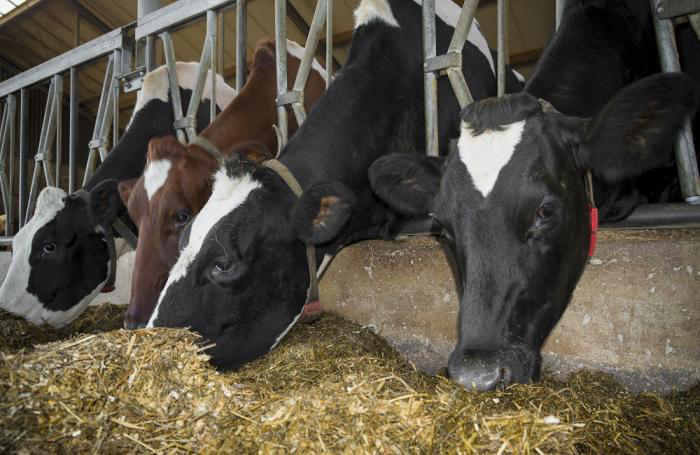Silage Crops for Dairy and Beef Cattle

This year's difficult weather conditions may require use of alternative sources for forage
Livestock producers in the Midwestern United States are facing a shortage of hay and grass this summer, which means they need to consider forage alternatives.
The Ohio State University Agronomic Crops Network explains the best options for alternatives sources of forage this summer.
1. Corn plant silage
While corn plant silage has the highest potential yield, silage quality will decline as planting is delayed. The biggest risk with late-planted corn is getting moisture down to a reasonable level at harvest. Corn planted into July will not make corn silage because it won't have many ears and will be low in starch. This silage will primarily be a source of fiber with potential yields about half of normal.
2. Forage sorghum
Brown midrib (BMR) varieties are best for lactating cows, but conventional varieties are acceptable if BMR seed is not available. A mid-September cutting will optimize quality for milking cows. An early October cutting will have a much higher yield, but the higher-fiber forage will be more suited for heifers, dry cows or beef cattle.
3. Sorghum-sudangrass
Similar to forage sorghum, BMR varieties are best for lactating cows, but conventional varieties are acceptable if BMR seed is not available. Sudangrass harvested at 50 days of growth is an acceptable feed for dairy cattle. At a 60-day harvest range, it is more challenging to feed to dairy cows for good milk production.
4. Sudangrass
BMR varieties are best for lactating cows, but conventional varieties are acceptable if BMR seed is not available.
5. Oat or spring triticale silage
This is a safer option than corn silage, but has a lower yield. It can be mowed and allowed to wilt to correct harvest moisture. Spring triticale is commonly planted as a hay or haylage crop and can produce high levels of dry matter under challenging conditions. It is later maturing than oats or barley and will maintain its forage quality for an extended harvest window.
Do not plant these for silage before the last week of July or overall yield will suffer. The overall potential yield is the lowest of the forage options. The potential feed value of oat will be similar to mid-bloom alfalfa. As a grass, inclusion rates in a lactating cow diet would have to go down, but it is a very acceptable feed.
6. Oat and winter rye mixed silage
This has the advantages of oat silage with a slightly higher yield in the fall and the potential for rye silage harvest in the spring.
7. Italian ryegrass silage
This crop emerges as fast as oats and could produce up to 1 ton of dry matter per acre in the fall if planted in August, but less yield if planted into September. This crop would also be available for additional cuttings next year, starting in late April or early May and then every 25-30 days.
To avoid damaging mold growth in winter, make a late fall cutting or graze to a height of 3 inches. This crop will shut down by mid- to late-summer the year after a fallen establishment. As a grass, harvesting earlier optimizes quality. Next year, the crop will head out quickly at each harvest.
Overall, it is a medium quality forage, but with proper diet, this formulation can work for lactating cows.
8. Soybean silage
Soybean silage is a reasonable replacement for alfalfa. Soybeans planted in mid-July and harvested as silage will yield about 2 tons of dry matter per acre. Silage harvest will be easier than dry hay because of difficulty in getting the crop dry. Silage harvesting later creates issues with the high oil content of the beans, and more leaf shatter will inhibit a good fermentation. Feed quality would be similar to early bloom alfalfa.
9. Teff
Teff is a warm-season grass that can be used for hay, silage or pasture best suited for sheep and beef. It has lower yield than sorghum grasses despite multiple harvests being possible. The first crop should be ready in 40 to 50 days. It may produce up to 2 to 2.5 tons per acre of dry matter in multiple cuttings and can tolerate drought-stressed and waterlogged soils. It should be planted as soon as possible because it dies at the first frost.
10. Millets
These summer annuals can be used as hay, silage, green chop and pasture. There are varietal differences between the pearl, foxtail, proso and Japanese types. There is evidence that pearl millet may cause butterfat depression in lactating dairy cows. Millet forages are better suited for beef, sheep or dairy heifer feed.
11. Brassicas
Brassicas have very low fiber and high energy and should be treated more like a concentrate than as forage in diets. These species contain high moisture content, so they should be used for sheep and beef grazing only.
Turnip, swede, rape, kale and other brassica species and hybrids are highly productive annual crops that can be grazed 80 to 150 days after seeding. When planted by early August, they can extend the grazing season in November and December.
williamsonagerelf.blogspot.com
Source: https://www.feedstrategy.com/dairy-cattle-nutrition/11-forage-alternatives-for-midwest-us-livestock-producers/
0 Response to "Silage Crops for Dairy and Beef Cattle"
Postar um comentário